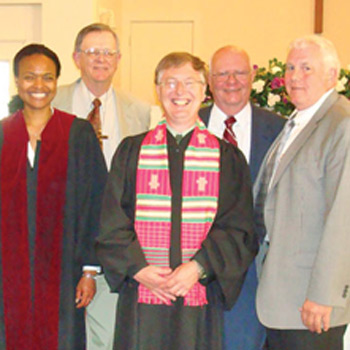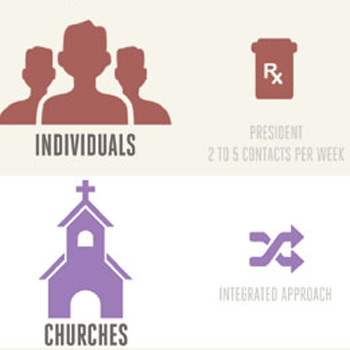
Enrollment at North American theological schools is flat or declining. If that’s not true at your school, you’ve dodged a bullet — for now. In 2013, In Trust published two articles that explored enrollment data in detail:
- “Sobering Figures Point to Overall Enrollment Decline” by Barbara G. Wheeler and Anthony T. Ruger (available at www.intrust.org/enrollmentresearch).
- “More Schools, Fewer Students” by Greg Henson and Gary Hoag (available at www.intrust.org/moreschoolsfewerstudents).
Both articles serve as reminders that boards and senior administrators of theological schools must pay close attention to the enrollment team — both the lead enrollment officer and the whole enrollment staff. After all, growing and maintaining enrollment is one of the most important leadership initiatives facing seminaries today.
Yet many board members may be unaware of what questions they should ask. After all, no board wants to meddle unnecessarily in administrative affairs. How can a board know what the appropriate big-picture questions are? Here are four questions that boards, presidents, academic deans, and other senior administrators should consider asking their enrollment team.
1. How well do we distinguish ourselves from similar schools?
One of the most important jobs of the lead enrollment officer is to be an advocate for prospective students to the board, faculty, and administration. These prospects are the school’s future, but they are not yet present to communicate their needs. In light of this, the lead enrollment officer can be their embodied campus voice by suggesting programs, infrastructure, and resources that future students will need when they eventually enroll.
In the past it may have been adequate for the admissions director to be mostly a file reviewer and gatekeeper, but that day is long gone. The lead enrollment officer should be one of the most forward-looking members of the whole institutional team. Why? Because over the course of a year, the enrollment team engages in hundreds of conversations with potential students; these conversations are opportunities for informal market research, which requires paying attention to what prospective students want and need.
No single theological school can be everything that every prospective student wants, so the lead enrollment officer needs the wisdom and experience to discern which ideas should be proposed to the senior leadership team as new initiatives. The best enrollment officers understand the institution, anticipate what challenges will arise in the next few years, and cultivate a realistic sense for near-term goals that can help the institution thrive. The enrollment office won’t be the final word on creating new programs, but wise presidents, faculties, and boards listen carefully to the enrollment team’s findings.
2. How do current enrollment metrics compare with prior years?
Most enrollment officers love promoting the institution to prospective students. But for some, thinking quantitatively and systematically about enrollment operations is more of a challenge.
You cannot manage what you do not measure, so one of the first steps toward constructive enrollment management is to determine key indicators. It’s important to gather the right information. Is your enrollment database up to date? Are your data-gathering methods consistent? Is the staff trained? If not, updating the database and training the team to use it effectively should be a first priority. 
If information has been carefully collected with a mission-driven strategy in mind, the lead enrollment officer should demonstrate a solid grasp for how today’s metrics relate to prior years. Among the most important data to monitor are inquiries and applications — these figures predict next year’s enrollment, so you can spot future problems months in advance.
Enrollment figures are seasonal, so comparing one month to the next is of limited value. Comparing each metric to the same month or quarter last year (or over several years) is usually much more helpful. At minimum, boards should ask the lead enrollment officer for an annual report of inquiries, applications, deposits, and matriculated students. The senior administrative team should receive briefings more regularly.
3. Are we attending to student fit?
While some institutions are surely tempted to admit subpar applicants in order to boost enrollment, admitting the wrong students is not a sound path to long-term financial sustainability, since students who don’t fit the institutional profile absorb more institutional resources than those who do. Student quality is one of the necessary ingredients for enhancing the education of all students, and it also affects the job satisfaction of faculty and staff. It’s the lead enrollment officer’s job to find the best mix of students to meet the school’s goals, taking into account both the number of incoming students and their quality according to various markers.
The key word here is “fit,” not “quality.” Applicants to theological schools are different from undergraduates and even from applicants to other kinds of graduate programs — for example, many are older, returning to higher education after years in the workforce. But an effective enrollment team understands the unique strengths of the institution’s various degree programs and can steer a prospective applicant in a wise direction. Sometimes a student who is inadequate for admission to one program can be right for a different degree.
Student fit also keeps an eye on diversity. One great challenge in today’s American religious landscape is the sharp stratification of differing ideologies, orientations, and backgrounds. A lead enrollment officer who is attentive to student diversity can do much to attract students from diverse orientations, improving classroom discussion, encouraging alternative viewpoints, and enhancing learning among all students.
4. Is the lead enrollment officer integrated into the institution’s leadership team?
As the primary liaison between the institution and its future student body, the lead enrollment officer should be included in key conversations about curriculum, scheduling, facilities, strategic priorities, marketing, and finance. It may not be realistic to have the enrollment officer involved in the details of each of these areas, but the enrollment officer’s input on big-picture issues is critically important. If the lead enrollment officer is not a member of the institution’s core leadership team, it’s worth considering whether to upgrade the position and make the lead enrollment officer a member of the cabinet.
Collaboration between the enrollment office and the broader leadership team ultimately improves admissions-related decision making by providing useful feedback about the proper mix of incoming students. Without the lead enrollment officer being integrated into key structures throughout the institution, it’s difficult to develop a cohesive and sustainable institutional strategy.




























